This is a recipe for a hot milk cake, a sponge cake that makes a great base for layer cakes and trifle. This is an easy sponge cake recipe that you can use to make Victoria sponge cake, fraisier and framboisier cakes, and berry trifles.

What is a hot milk cake?
The hot milk cake is a wonderfully light and fluffy sponge cake: when you press on it lightly with your finger, you can hear the sound of the air releasing from inside the tiny bubbles of the cake, like pressing a sponge.
It gets its name from the ingredients used to make this particular type of sponge cake: it's made with milk that was warmed to hot enough to melt the butter.

You could compare this sponge cake to a genoise, but this is much, much easier to throw together: you don't need to careful fold the flour into airy, whipped eggs and sugar. Yet this cake is more airy and tender than a classic génoise because of the milk in the cake batter and also the leavening agent used.
In my family, we actually don't call it a hot milk sponge cake and it's called a "Zilla's cake" on my grandmother's recipe card. We don't know who Zilla is though.
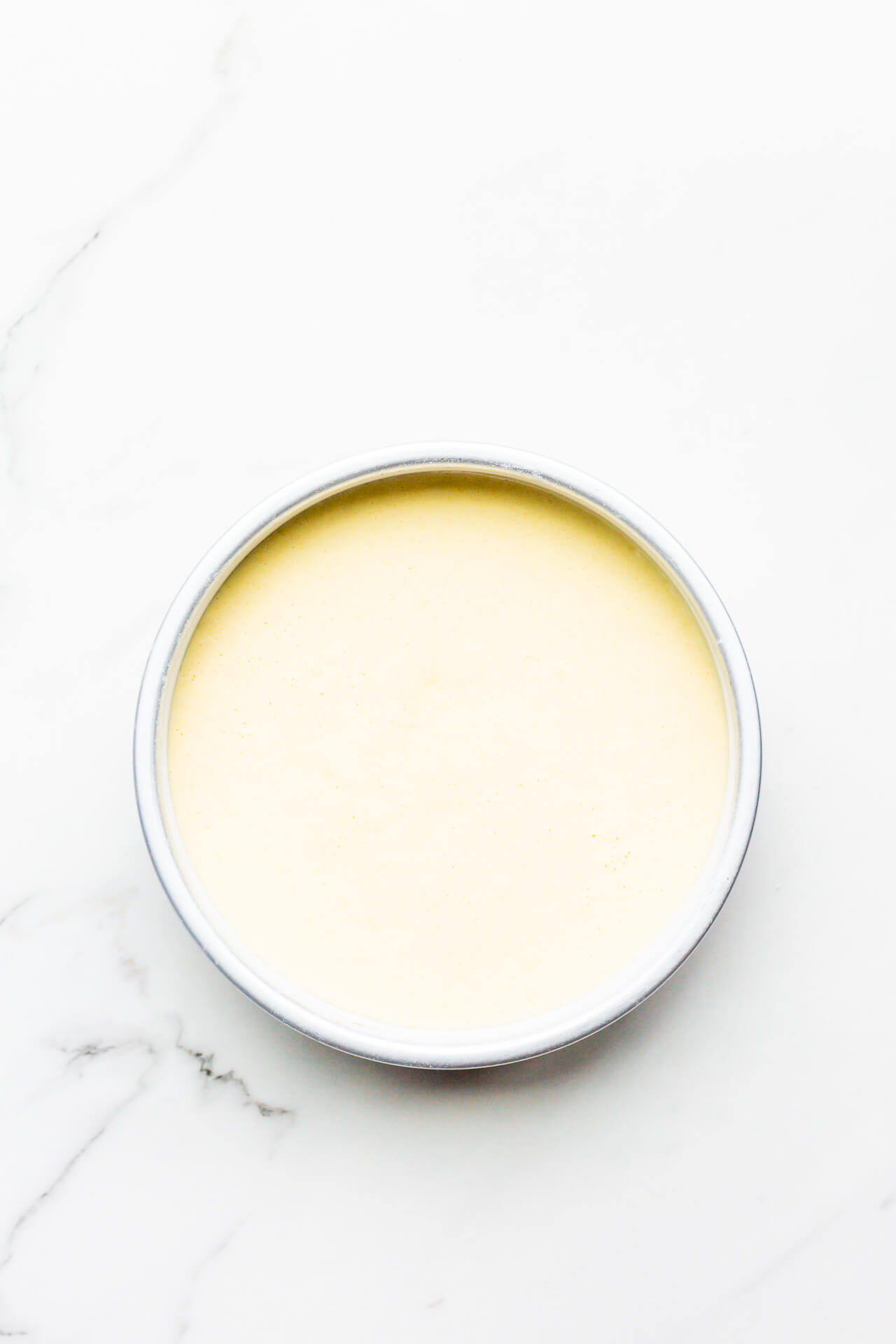
Ingredients to make it
This cake is a classic British recipe made from simple ingredients that most bakers and households have on hand at all times.
As suggested by the name of it, this cake is made with hot milk (or warm milk) and also melted butter, two ingredients that aren't usually included in most sponge cake recipes. The milk and the butter make for a tender cake that is even lighter than classic sponge cakes. Some recipes also include oil, which will give a more moist texture and mouthfeel than butter does.
This recipe calls for a chemical leavener, baking powder, which gives this sponge cake a more open crumb and a light texture.

How it's made
I think this is the easiest sponge cake you can make. Like most sponge cakes, the mixing method involves whipping the eggs with the sugar for several minutes to incorporate air and create volume. The mixture will be quite thick and when you lift the whisk, the batter falls off like a ribbon and is quite stable.
The baking powder also helps create more volume as the cake bakes, which means you don't have to be so worried about folding in the dry ingredients into the whipped eggs to maintain that air and volume: the baking powder will compensate for any loss of air during the mixing so you always get a light cake, even if you under-whipped the eggs or mix the batter a little too roughly.

What to bake it in
My mom always bakes the hot milk sponge cake in a tube pan, which is similar to an angel food cake pan, except the bottom of the tube pan isn't removable. The cake bakes pretty flat in the tube pan and she usually slices it to make trifle with it in the summer.
I usually bake it in a round cake pan, in an 8-inch cake pan for a thicker cake, or in a 9-inch pan for slightly thinner layers. If you want to bake this recipe in an 8-inch cake pan, make sure it has a 2-inch height. Otherwise, in a shorter 1.5-inch tall pan, the batter may overflow.
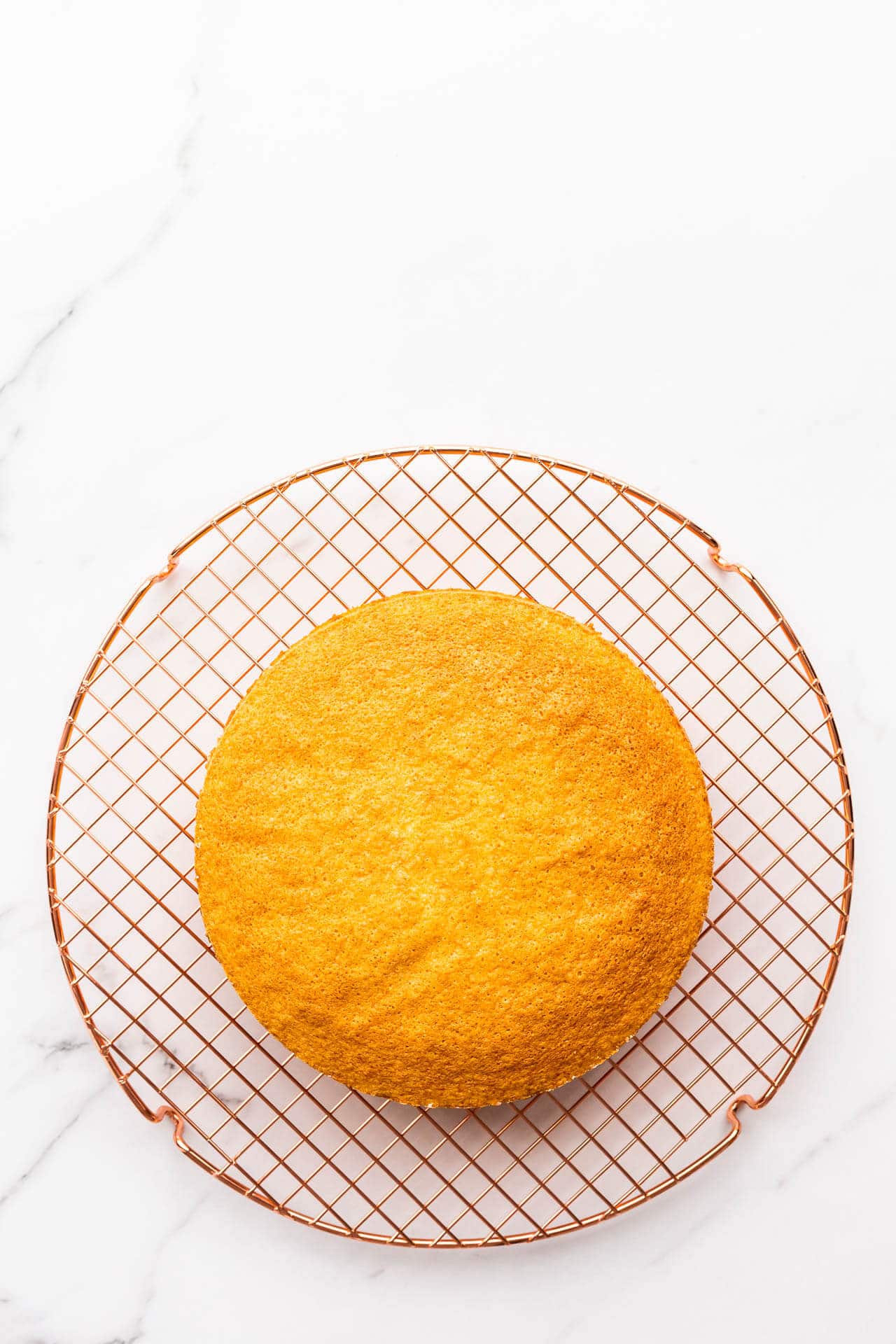
If you don't have an 8-inch cake pan with 2-inch sides, feel free to bake it in an 8-inch springform pan.
I've also baked this recipe in a square 9x9 cake pan (a brownie pan) and even a loaf cake pan. Both of these pans also work for this recipe. It all depends on what you want to make with the baked cake.

What to make with sponge cake
The tiny bubbles and spongy texture of this cake make it ideal for soaking flavourful syrups, or liqueurs like sweet sherry. Use it to make:
- Trifle, like this berry trifle in summer or an eggnog trifle in winter, layered with pastry cream and whipped cream.
- Framboisier or fraisier cakes filled with mousseline cream from pastry cream and fresh berries like raspberries or strawberries.
- Victoria sponge cake layered with whipped cream and berries.
- Lamingtons, like these raspberry lamingtons, are squares of sponge cake dipped in jam, melted chocolate, or salted caramel, and coated in shredded coconut.

Keys to success when baking hot milk cakes
The hot milk cake is a sponge cake, so there are a few important steps to take to ensure you will be successfull:
- Sift the dry ingredients together (flour, baking powder and salt) in order to lighten the dry mixture, to remove clumps, and to help these ingredients mix evenly into the cake batter. You can triple sift to be sure that they are properly mixed, or you can sift into a bowl and then whisk them.
- Use an electric hand mixer or a stand mixer. In order to whisk the eggs and the sugar enough to incorporate more air, I recommend using an electric mixer or a stand mixer. Sure, you can whisk the two ingredients together with a whisk by hand, but it will take longer, and you may not achieve the same volume, nor incorporate as much air.
- Whip the eggs with the sugar for several minutes (even 5 minutes if you are using an electric mixer). You want the mixture to be very light, airy, and thick. The mixture should be stable. When you lift the beater over the mixture, it should fall back like a ribbon that doesn't disappear right away.
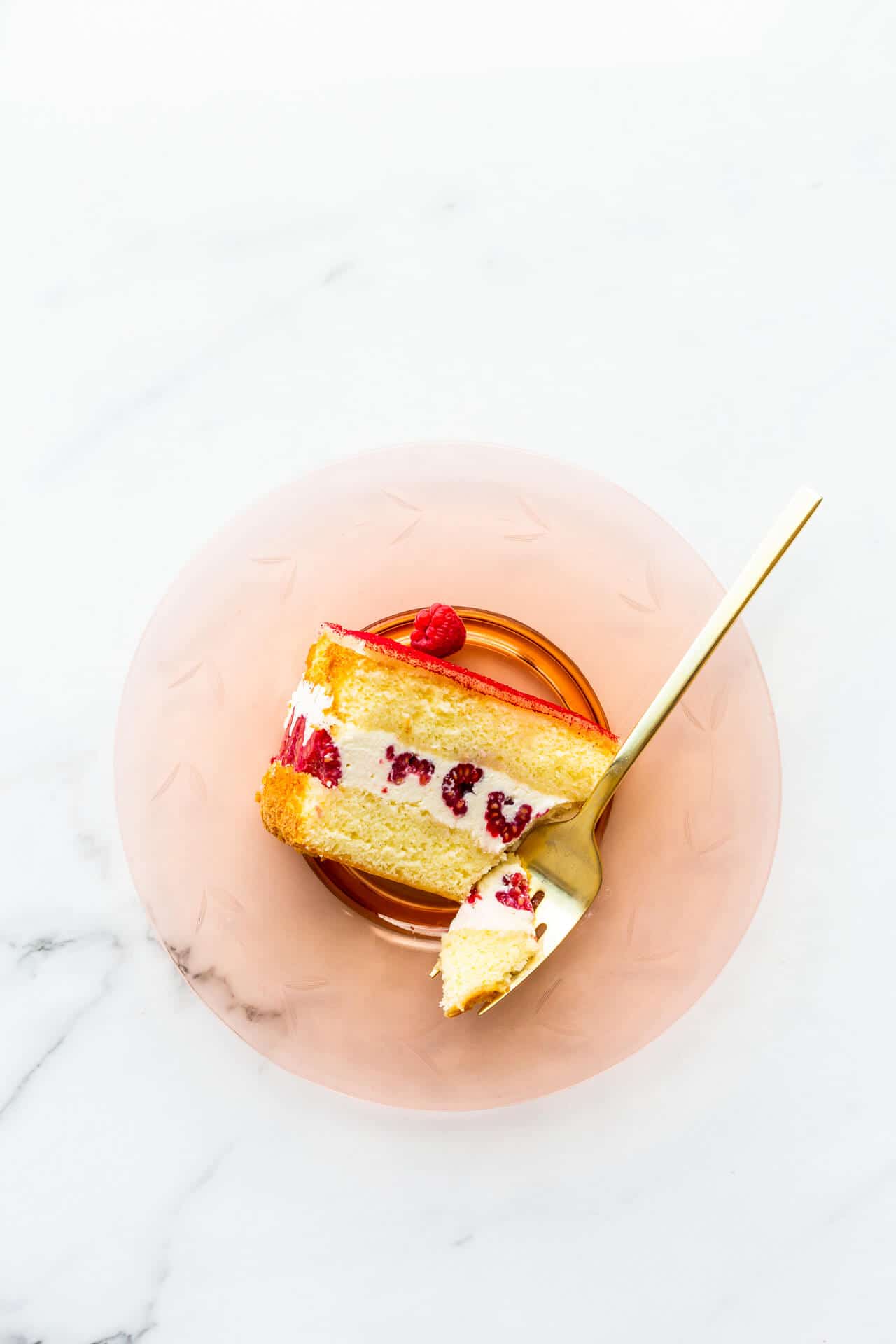
This hot milk cake recipe is my mom's favourite cake and it's a recipe we all go back to year after year, passed down from her mom. And now, I'm passing it on to you so that you can enjoy it too! You can use this recipe to make the framboisier cake.

📖 Recipe

Hot Milk Cake
Ingredients
- 125 grams bleached all-purpose flour
- 5 mL baking powder
- 1.25 mL Diamond Crystal fine kosher salt
- 125 mL whole milk (3.25 % fat) skim milk or whole milk will also work here
- 15 grams unsalted butter
- 5 mL pure vanilla extract
- 2 large egg(s)
- 200 grams granulated sugar
Instructions
- Preheat the oven to 350 ºF (175 °C). Butter and flour an 8-inch cake pan or an 8-inch springform. Line the bottom with parchment paper. Set aside.
- Sift the flour with the baking powder and salt into a medium bowl. Set aside.
- In a small saucepan (or in a microwave safe bowl), heat the milk with the butter until the butter is melted on low heat. Add the vanilla and let cool slightly.
- In the bowl of an electric mixer fitted with the whisk attachment, whip the eggs with the sugar until very light and fluffy. The mixture should at least double in volume, if not more.
- Add dry ingredients alternately with wet ones.
- Bake for 35 minutes or until golden brown. A cake tester inserted into the middle should come out clean. The cake will be spongy and light and spring back when gently pressed.
- Let cool slightly before unmoulding onto a wire rack to cool completely.
Notes
- When adding the wet and the dry alternately, remember to start and end with the dry. Thus: dry, wet, dry, wet, dry. This is one of the golden rules of baking, although I’m not quite sure why.
- We always butter (or spray with cooking spray) the inside of the pan and coat it with sugar (not flour) because sugar is delicious, whereas a layer of flour on the outside of a cake can taste gross. This means that you have to be very careful and get the baked cake out of the pan when it is just cool enough to release from the pan, but not so cool that the sugar has recrystallized, thereby irreversibly gluing the cake to the inside of the pan. Let it cool a maximum of 10 minutes before removing the cake from the pan.
- The 35-minute baking time is pretty exact. Normally, my mom and her mom would bake this in a tube pan (like an angel food cake pan). It always takes exactly 35 minutes for the cake to bake. No joke. This time, I chose to deviate from the tradition, and I baked it in a loaf pan. And, once again, it came out perfectly! The only difference was that it baked for 47 minutes. Now, I’ve only baked it once in the loaf pan, so I cannot say for sure that it will take you 47 minutes. So start checking it after 45 minutes, or when you notice the edges coming away from the sides.
Nutrition
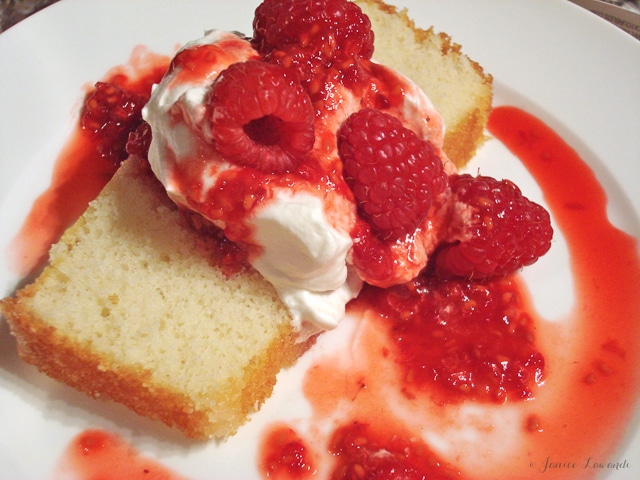


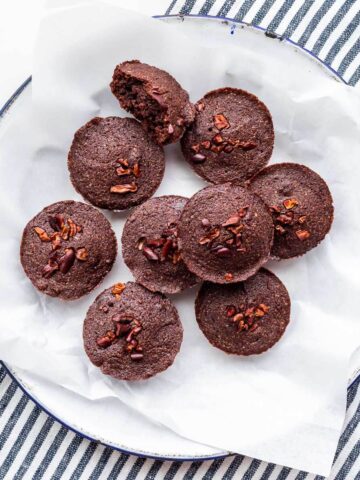



Paula says
Super easy recipe to follow would recommend 40 mins if baking in a loaf tin.
Lauri says
Could this be baked in a bundt pan?
Janice says
Hi Lauri,
I have never tested this recipe in a bundt pan. The cake doesn't usually stick to the pan if you prepare it properly (buttering and flouring) but I'm worried if the pan design is intricate, that it may lead to trouble. My mom often bakes this exact recipe in an tube pan (like for angel food).
Let me know if you do try the bundt pan, and if it does stick, break the cake into pieces and make trifle 😉
Saranya says
Hi,
Can i use this cake as a base cake for white forest cake, strawberry cake and so on...
And i can see many bakers using oil to make sponge cake instead butter. Does it taste good??
Please share me your suggestions on making sponge cake??
Janice says
Hi Saranya! Great questions! Many bakers favour oil because it's liquid at room temperature. This means that cakes made with oil may seem moister than those made with butter. Butter is solid at room temperature and quite hard and brittle when refrigerated so cakes made with butter can sometimes seem dryer.
This cake makes a great base for layer cakes, especially with fruit and soaking syrups, which I'd imagine both the white forest cake and strawberry cake you mention will have! It's very versatile and has a nice light texture! For example, I use it as a base for a framboisier cake (like a fraisier but with raspberries instead of strawberries).
I hope this helps! Let me know if you try the recipe!
Dena Fox says
My batter had lots of tiny air bubbles on top - they caused a crisp top.
Janice says
Hi, You can try banging the filled pan(or spinning it) on your counter to try and release some of that air, but if it created a crispy top, it could be an issue with the sugar not being dissolved enough, thus creating a crust on the top of the cake. It could mean you need to beat the sugar and eggs longer, or more slowly, to give more time for the sugar to dissolve. Hope that helps and that the cake is still yummy!
Folashade says
Great